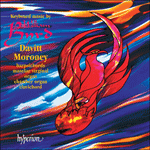
Welcome to Hyperion Records, an independent British classical label devoted to presenting high-quality recordings of music of all styles and from all periods from the twelfth century to the twenty-first.
Hyperion offers both CDs, and downloads in a number of formats. The site is also available in several languages.
Please use the dropdown buttons to set your preferred options, or use the checkbox to accept the defaults.

| Davitt Moroney (muselar)» More |
The third strain starts on the chord of F major, emphasizing the Mixolydian mode. For some reason there appears to be no galliard associated with this or the next work. Being a ‘16-bar’ pavan, running to 96 semibreves, Byrd cannot have intended any association with the unattached galliard in the same Mixolydian G major (BK77). In any case, the absence of a galliard in the authoritative Nevell source would virtually forbid our linking one with it. This pavan is one of Byrd’s most concentrated and demanding works, with a particularly rich harmonic language and an unusually plangent treatment of dissonance.
from notes by Davitt Moroney © 1999
La troisième strophe commence sur l’accord de fa majeur, pour souligner le mode mixolydien. Pour une raison inconnue, il n’y a pas de gaillarde. Puisqu’il s’agit d’une pavane “à seize”, avec six sections et quatre-vingt-seize semi-brèves, Byrd n’a pas pu vouloir la mettre en paire avec la gaillarde solitaire en sol majeur (BK77), qui n’est qu’“à quatre”. En tous les cas, l’absence de gaillarde dans Nevell, une source de si grande autorité, interdirait d’en ajouter une. Cette pavane est parmi les plus concentrées et les plus ardues de Byrd. Son langage harmonique est unique, avec des dissonances particulièrement retentissantes.
extrait des notes rédigées par Davitt Moroney © 1999
 Byrd: Keyboard Music Byrd: Keyboard Music‘Here, now, is a clever selection featuring all six of his instruments including the captivating muselar. Essential listening’ (BBC Music Magazine) ‘A good compilation, showcasing Moroney’s playing as well as the breadth and richness of Byrd’s output’ (Early Music Review)» More |

